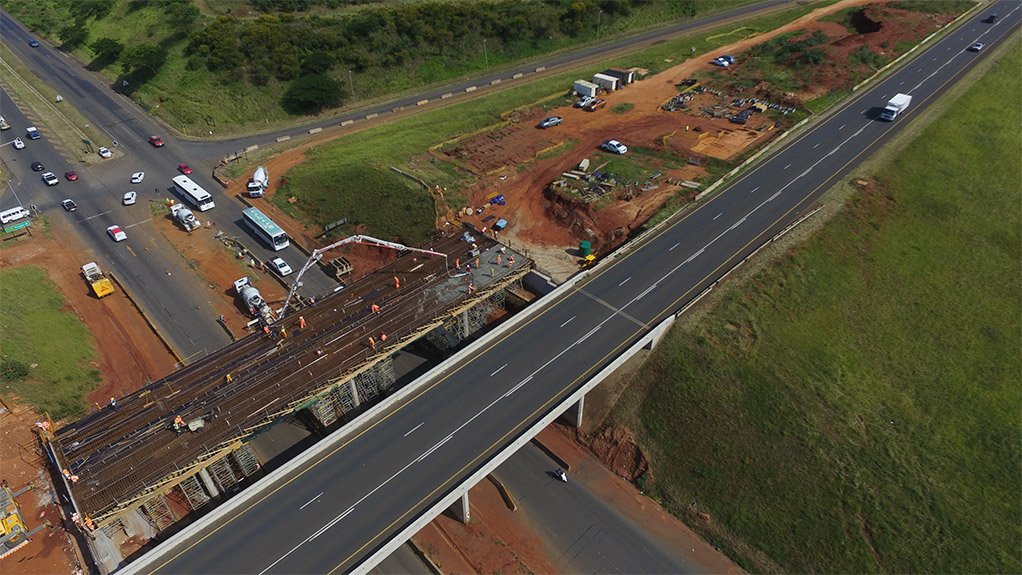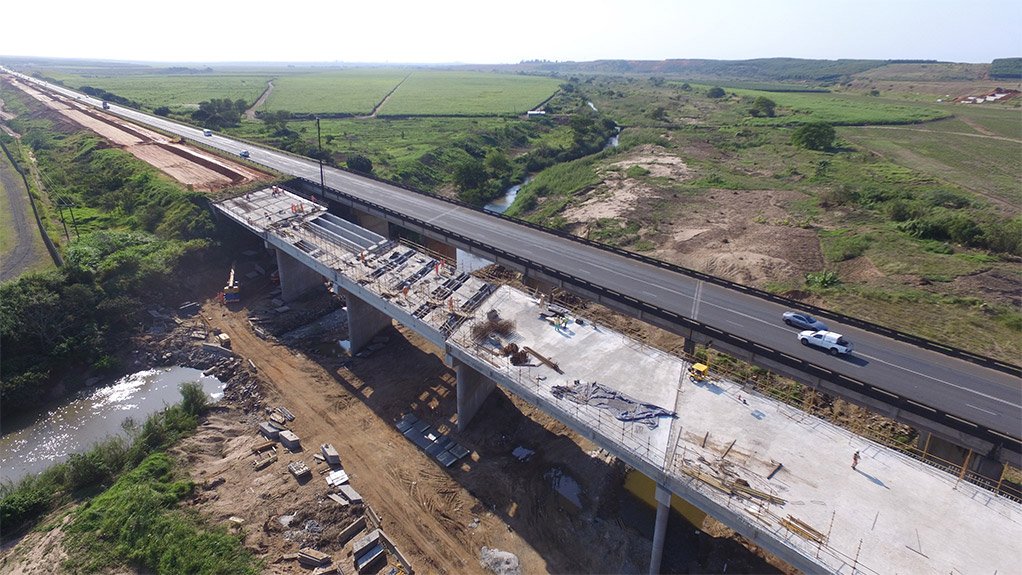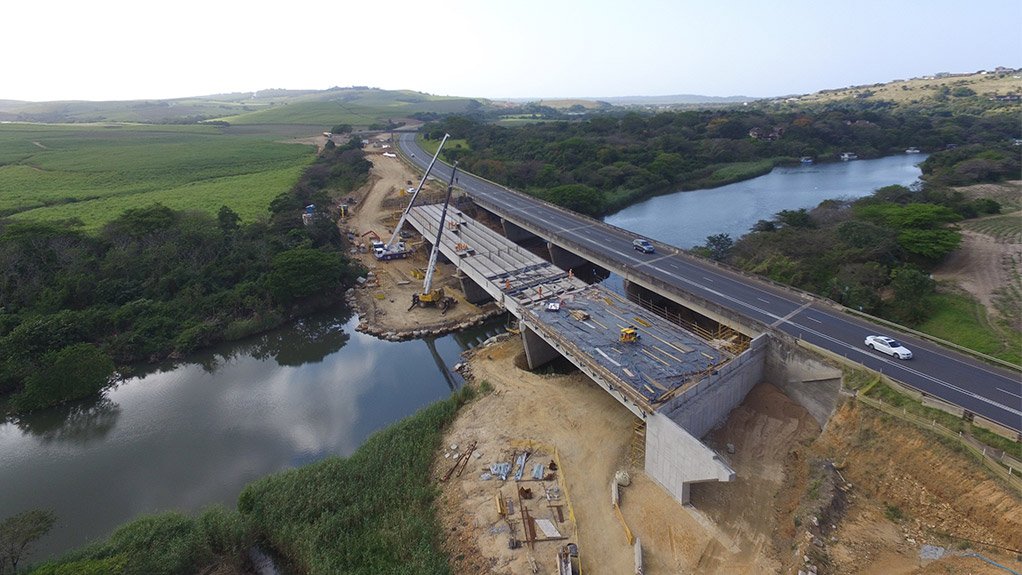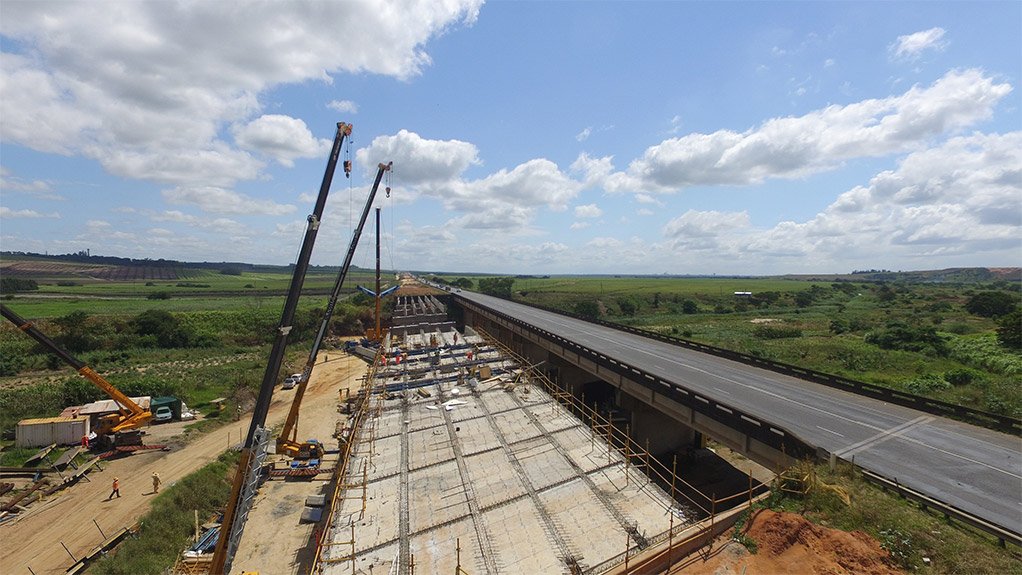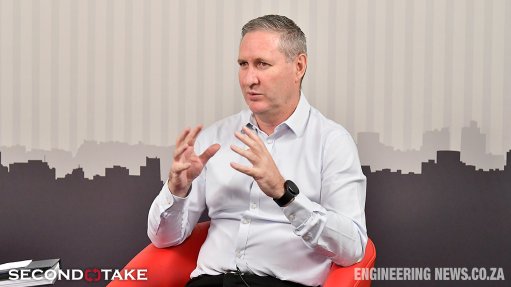Large Bridges Showcase Concor Infrastructure Expertise On N2 Road Contract
This article has been supplied as a media statement and is not written by Creamer Media. It may be available only for a limited time on this website.
Concor Infrastructure has made solid progress constructing and extending more than eleven structures, including two large bridges and four overpass bridges, on the exciting N2 highway upgrade between Mtunzini and Empangeni in KwaZulu-Natal.
This substantial South African National Roads Agency SOC Limited (SANRAL) project includes the construction of a new northbound carriageway and the rehabilitation of the existing road to form the future southbound carriageway on a 34 km section of this national route.
The number of river crossings meant that ground conditions were often unpredictable. Proximity to the coastline also lent a tidal element to the levels of one of the rivers – a factor which had to be accommodated in the construction methodology.
According to Kyle McDonald, Concor Infrastructure engineer on the project, the two large bridges are among the engineering highlights of the project, requiring construction and placement of 30 metre precast, post-tensioned beams. The precast beams were constructed by a sub-contractor supplied with concrete from a batch plant established at the precast yard, approximately in the centre of the 34 km project.
The largest of the new bridges is a 240 metre, eight-span structure over the uMhlathuze River. It comprises eight simply supported 30 metre deck spans carried on solid reinforced concrete wall-type piers on piled foundations with pier heads and closed-type abutments, also on piled foundations. The overall bridge width between parapets caters for a 14,4 metre roadway and caters for future widening to an eight lane configuration.
Supporting the deck are 48 precast post-tensioned I-beams, as well as previously extended abutments and seven new wall-type internal pier supports. Each new pier rests on ten piled foundations of 900 mm diameter bored and augured-type piles ranging in depth from 48 to 60 metres. The piers were built in three lifts using specialised formwork, while the construction sequence enabled continuity in the placement of the precast beams and the construction of the deck spans.
The next largest structure is the bridge over the uMlalazi River. At 120 metres long, this four‑span bridge is also simply supported with three internal wall-type piers with pier heads and closed cantilever-type abutments with return walls and earwings. With 28 precast beams supporting the deck, the south abutment and pier 1 are founded on pad-type footings while piers 2 and 3 – as well as the north abutment – are built on piled footings.
Access to the piers was by platforms constructed from either bank and protected by an outer lining of over 2,600 geo-revetment sandbags, which minimised siltation flows into the rivers. These acted as geotextile traps on the edges of the platforms ensuring that fine material was not washed into the river during the bridge building stages, thereby preserving water quality and river life. The platform on the south-west side of the river gave Concor Infrastructure access to pier 1, while the second platform from the north-east provided access to piers 2 and 3.
In addition to the two large river bridges, the project includes four overpass extension bridges, two road-over-rail bridges, a large box culvert-type bridge, a road-over-provincial-road bridge and an interchange bridge.
The overpass structures – Ridge Bridge, Windy Ridge, Port Dunford and Mzingwenya – were previously three-span bridges with articulated decks consisting of circular voided post-tensioned deck sections. They were lengthened about 30 metres into four-span structures, using similar articulation and a post-tensioned box voided deck.
New piers have been built as wall-type tapered columns on 600 mm diameter Continuous Flight Auger (CFA) piled foundations, except for Ridge Bridge with conventional spread footing. Windy Ridge Bridge took six piles for its pier while the Port Dunford Bridge and Mzingwenya Overpass have four piles for each pier. The new abutments are short wall-type structures founded on perched spread footings.
Construction generally began with the removal of northern jack spans by crane, and the demolition of jack spans and abutments. Widened road prisms were excavated and piles were installed on which the piers were built. New post-tensioned box decks were constructed, followed by new west abutments and new reinforced concrete jack spans. Parapets were then built, after which the asphalt was placed on the deck and the bridge completed.
The Port Durnford and Mzingwenya bridges were different. They had to be jacked vertically by approximately 500 mm to increase the clearance above the existing road and existing piers and abutment extended to accommodate the new higher levels. This had to be done over live traffic to ensure the N2 road was operating normally.
Both bridges’ identical 380 ton decks were jacked using four hydraulic jacks, attached to a Concor Infrastructure in-house designed jacking structure fixed to the existing piers and bolted to the base and deck; this ensured a rigid structure to elevate. The deck was elevated by 1.2 metres to allow sufficient space to extend the existing piers, and then lowered into final position on new pot bearings.
Port Dunford Bridge II – which carries the N2 over the P537 provincial road – is a simply supported deck of 27 inverted precast T-beams with in-fill concrete. It is supported on mechanically stabilised earth wall abutments. With a span of some 16 metres, it is 13,4 metres wide to accommodate an additional two traffic lanes of 3,7 metre wide, including shoulders and painted islands.
Providing access over the Stanger-Empangeni rail line is the UMhlathuze Rail Bridge, which is a single-span precast post-tensioned structure. It is a type-M beam and slab bridge with closed face abutments and asphaltic plug-type joints. Its abutments are mechanically stabilised earth walls with a reinforced concrete impact wall in front. Of similar construction is the Empangeni Rail Bridge over the Empangeni-Richards Bay railway, which has a central pier of three wall type columns supported on 18 friction grip CFA piles 13 metres deep.
Crossing the R34 road between Empangeni and Richards Bay is the Empangeni Interchange Bridge – now a four-span, solid quad spine-beam structure with reinforced concrete deck. The wall-type piers are each founded on seven augured piles of 900 mm diameter, ended by closed abutments each on 10 augered end bearing piles of the same size.
These 11 main bridge structures – which have been constructed on a total of 161 piles – have required over 20,000 m3 of concrete and 2,307 tonnes of steel reinforcing. Apart from these major structures, Concor Infrastructure has also constructed 21 major in-situ drainage culverts and access underpasses as part of this contract and more than 130 minor drainage precast portal and pipe culverts.
Comments
Press Office
Announcements
What's On
Subscribe to improve your user experience...
Option 1 (equivalent of R125 a month):
Receive a weekly copy of Creamer Media's Engineering News & Mining Weekly magazine
(print copy for those in South Africa and e-magazine for those outside of South Africa)
Receive daily email newsletters
Access to full search results
Access archive of magazine back copies
Access to Projects in Progress
Access to ONE Research Report of your choice in PDF format
Option 2 (equivalent of R375 a month):
All benefits from Option 1
PLUS
Access to Creamer Media's Research Channel Africa for ALL Research Reports, in PDF format, on various industrial and mining sectors
including Electricity; Water; Energy Transition; Hydrogen; Roads, Rail and Ports; Coal; Gold; Platinum; Battery Metals; etc.
Already a subscriber?
Forgotten your password?
Receive weekly copy of Creamer Media's Engineering News & Mining Weekly magazine (print copy for those in South Africa and e-magazine for those outside of South Africa)
➕
Recieve daily email newsletters
➕
Access to full search results
➕
Access archive of magazine back copies
➕
Access to Projects in Progress
➕
Access to ONE Research Report of your choice in PDF format
RESEARCH CHANNEL AFRICA
R4500 (equivalent of R375 a month)
SUBSCRIBEAll benefits from Option 1
➕
Access to Creamer Media's Research Channel Africa for ALL Research Reports on various industrial and mining sectors, in PDF format, including on:
Electricity
➕
Water
➕
Energy Transition
➕
Hydrogen
➕
Roads, Rail and Ports
➕
Coal
➕
Gold
➕
Platinum
➕
Battery Metals
➕
etc.
Receive all benefits from Option 1 or Option 2 delivered to numerous people at your company
➕
Multiple User names and Passwords for simultaneous log-ins
➕
Intranet integration access to all in your organisation



